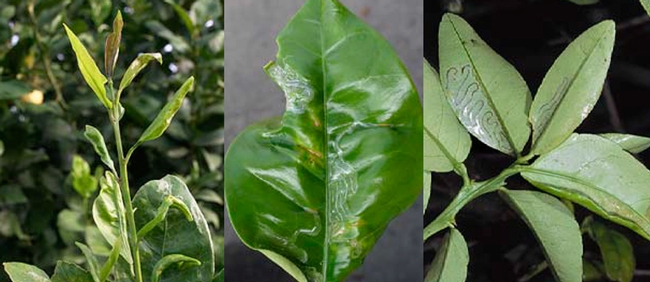Advice From the Help Desk of the UC Master Gardener Program of Contra Costa County
Client's Question: The photos show what several of my dwarf lemon tree's leaves look like. I had several leaves look the same last year, but I thought it was just a one-time occurrence and would go away when I took them off the tree awhile ago. However, as you can see on the picture, the condition is back. What is it and what can I do to protect the tree and fruit.

Original Pictures from UC Davis
http://anrcatalog.ucdavis.edu/pdf/8321.pdf
Response from the UC MGCC Program's Help Desk: This condition n the photo is not a disease. It is caused by an insect that,during its immature stages, burrows (“tunnels”) in the leaves. The insect is called a Citrus Leaf Miner. When it becomes an adult and exits the tunnels, it is a moth. Although the burrowing causes the leaves to become distorted, the leaves still provide food for the plant, so you should not remove them. There will not be any lasting damage from this insect. There is not any spray that can prevent this, because the insect larva is protected inside the leaf. The best way to reduce the infestation is to not fertilize your citrus during summer or fall, since this is the time the moth is active. Fertilizing causes new growth, and the new leaves are much more susceptible to the Leaf Miner than older, hardened leaves. Citrus should also not be pruned during this time, again because pruning also causes new leaves to emerge.
Citrus should be fertilized before bloom (January or February), and again in May. If fertilizer is needed (e.g., if the leaves are not a deep green color), apply additional fertilizer no later than June. Always follow label directions when applying fertilizer. More recommendations regarding fertilizer for Citrus can be found here
http://www.ipm.ucdavis.edu/PMG/GARDEN/FRUIT/CULTURAL/citfertilization.html
Additional information about Citrus Leaf Miner can be found at this University of California website http://www.ipm.ucdavis.edu/PMG/PESTNOTES/pn74137.html
Help Desk of the UC Master Gardener Program of Contra Costa (JL)
*******************
Editor's Addendum: The Citrus Leaf Miner has been in California for many years, mainly in Southern California. However, it became very obvious in Contra Costa County only a few years ago. I've seen Citrus Leaf Miner in my various citrus trees in Martinez for the last several years, and we've had many questions about Leaf Miner at the Help Desk for the last 2-3 years. In my citrus, it hasn't been a significant impact, but it is noticeable due to the obvious tunneling and distortions. Per the referenced Pest Note, I haven't really done anything to prevent and/or “cure” the infestation other than normal care. Anecdotally, the impact didn't seem to be as significant last year (2015), and I haven't really noticed any impact so far this year. The Pest Note indicates that there are natural predators that often follow the Leaf Miner so maybe they have finally arrived (woke up?) or some other predator has discovered this new “food”? We'll soon see as warmer weather arrives.
*******************
Come to the UC MGCC Program's Great Tomato Plant Sale
Walnut Creek 4/2&9, Richmond 4/9, and Antioch 4/16
Click for locations and plant lists!
Dozens of heirloom tomatoes & vegetables chosen especially for Contra Costa
Note: The UC Master Gardeners Program of Contra Costa's Help Desk is available year-round to answer your gardening questions. Except for a few holidays, we're open every week, Monday through Thursday for walk-ins from 9:00 am to Noon at 75 Santa Barbara Road, 2d Floor, Pleasant Hill, CA 94523. We can also be reached via telephone: (925) 646-6586, email: ccmg@ucanr.edu, or on the web at http://ccmg.ucanr.edu/Ask_Us/ MGCC Blogs can be found at http://ccmg.ucanr.edu/HortCoCo/ You can also subscribe to the Blog (//ucanr.edu/blogs/CCMGBlog/).